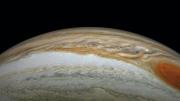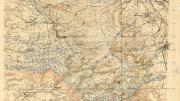Jupiter’s Great Red Spot is hard to overlook. Prominently displayed on every poster of the solar system, that churning storm has been visible for hundreds of years, possibly as early as the seventeenth century, when Giovanni Cassini and Robert Hooke reported a persistent spot on the planet’s surface. When Donato Creti painted stargazers consulting charts and looking up into the night sky in 1711, he highlighted Jupiter hanging above them, enormously magnified and almost glowing, sporting three bright moons and that big, red dot.
Yet the processes that gave rise to the storm and have kept it spinning all this time are still a bit mysterious. “There’s something truly extraordinary about the Great Red Spot,” says Mallinckrodt professor of geophysics Jeremy Bloxham of the department of earth and planetary sciences. “It’s existed for hundreds of years, and there’s only one.” In a new paper in Science Advances, Bloxham and his coauthors Rakesh Yadav, also at Harvard, and Moritz Heimpel of the University of Alberta, have presented a model showing how such large storms might arise—though they still cannot fully explain the spot’s peculiar persistence.
Yadav, a research associate in Bloxham’s group, says other explanations of the patterns on the gas planet’s surface tend to focus on the fluid dynamics of its top few hundred kilometers. Jupiter has no firm surface to speak of—its gases simply grow denser and are under greater pressure the closer they are to its core. But models often propose that storms (Jupiter has many) form in the uppermost layer. “It’s pretty natural to assume that they are…quite similar to what happens on Earth,” he explains. “Earth has a thin atmosphere lying on top of its surface, and we see storms and hurricanes there.”
But observations made by the Juno spacecraft orbiting the planet suggest a different state of affairs. Bloxham and other colleagues studying results from that mission, reported in 2018, noted that some of the jet streams—bands of circulating gas that wind around the planet like ribbons—seem to be structures thousands, not hundreds, of kilometers deep. That raised the question: could the storms be more than skin-deep, too?
The circulating fluids within gas giants generate their own magnetic fields as the planets rotate, which could contribute to the formation of those jet-stream structures. The researchers therefore created computer simulations representing the outer thousand or more kilometers of such a planet, deep enough that the influence of these circulating fluids could be modeled. Then they let the simulations evolve for weeks or months to see if storms would be generated.
One version of the model, with an atmosphere on the thinner side, soon created nearly a hundred storms. “It was just breathtaking to watch them,” Yadav reports, “because they almost look like things happening on Jupiter.” On the real planet, storms can swirl past each other, and may even merge, so that if one is going clockwise and the other counterclockwise, their winds cancel each other out. Where there were once two spinning vortices, there is an island of calm. “It was striking to see the same thing happening in the simulation,” he adds.
A version simulating conditions within a thicker and much deeper atmosphere produced something stranger still. There weren’t as many storms, but those that did appear were enormous. “We were quite surprised by the sheer size,” Yadav says. “When you see such a large storm, the first thing that comes to mind is the Great Red Spot.”
The fact that it has been tricky to get such large storms to arise in shallower simulations, he explains, buttresses the Bloxham group’s suggestion that the deeper levels of the planet may have an important role to play in what is seen on the surface.
But whatever is keeping the Great Red Spot going isn’t at work even in this model. The simulated storms have a lifetime of about 20 rotations of the planet—a blink of an eye compared to Jupiter’s persistent monstrosity.
The simulated storms may last longer in the future, when the computer power available for such modeling has increased, Bloxham explains. One important caveat of the new paper’s findings is that the fluids used in the models are much more viscous than those that swirl within Jupiter, which makes them easier to work with. They are more like honey than water, so their movements are more languid and less costly to simulate. Thinner fluid, once spinning in a vortex, would be less prone to slowing down.
As the Juno mission continues, more data about how Jupiter’s magnetic field affects the flows in its upper layers may well emerge. “I think with almost every planetary mission, people go off with one set of expectations of what they’re going to see, and invariably you see something different,” Bloxham points out. “It just shows us how little we understand what’s going on in our own solar system.”









